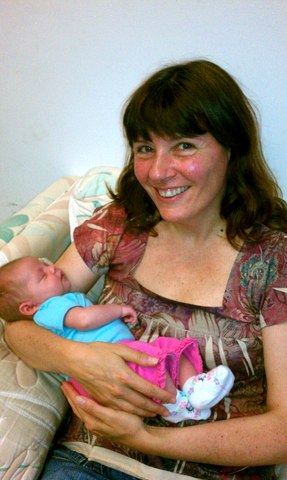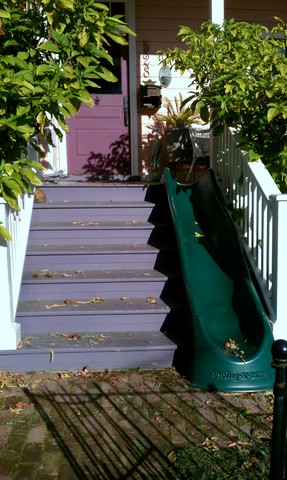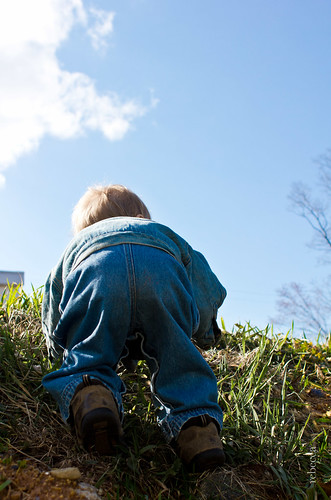“If today were the last day of my life, would I want to do what I am about to do today?” -Steve Jobs, Stanford commencement address 2005. (My answer is, “Yes, I would!”)
Right now, there are no words that come easily, and I’m no poet, so all I have to offer is unvarnished, straightforward, and honest facts. I’ve struggled with what (if anything) to say on this blog about recent changes in my life, but so many of you have opened your hearts, trusted me, and shared your most tender feelings, questions, and fears, I feel it’s important for me to return the favor.
Three weeks ago, the phone rang. From across the country, my aunt shared news that would turn my world upside down- my brother and my Dad both weathering serious health crises, and my brother and his girlfriend were expecting a baby, due August 7.
Little R. came into this world a bit earlier than expected, on July 22. A new life, precious and vulnerable. Because her parents were unable to assume caring for her, she was placed with a foster family under an emergency order. A week of sleepless nights, and countless phone calls and conversations later, I found myself on a plane to visit both my brother and my Dad, with no clear answers, and only a hope of actually being able to meet R.

Miracle of miracles, I was able to spend three hours with R. over the course of two visits in the week that I was in the state that I once upon a time (a lifetime ago) called my home. My brother and his girlfriend expressed a desire to have me assume R.’s foster care, and although the decision is ultimately up to the courts, I immediately realized that this was a request I could not and would not refuse- however, my husband was just as clear that this was a situation that he could not accept.
There are times in life when none of the choices are easy or ideal, and we are called upon to step up and live into our values and ideals even if it is hard and involves personal sacrifice. In this case, my course of action is clear, given who I am and what I believe in when it comes to babies and families in general, and this particular baby, who is a part of my family, and who is in need. This post, called Faithfulness, by Vanessa Kohlhaas, has been a source of inspiration, comfort, and food for thought in recent days.
“Our faithfulness is continuously tested. We do not get to be in relationship with others in a vacuum – and why would we want to. We are challenged in our relationships to change, develop and grow. And through this work we allow our love to deepen and grow with us.” Vanessa Kohlhaas
I am in the process of doing what I must do to prepare to move to Florida for the time being, to support my family and see them through to the other side of this crisis.There is sadness and loss, but there is also joy, and the promise of new beginnings, as I step into the unknown and say goodbye to the family I have loved and cared for for six years, and the community, friends, and life that I have built here in Santa Cruz, over the past three and a half years. It also means letting go of the wedding celebration Bence and I had been planning, and putting aside plans to grow Regarding Baby in new ways- at least for the time being.
There are more unknowns and unanswered questions than there are sureties right now, but if I’ve learned anything in the (almost) forty nine years I’ve been alive, I’ve learned that change is the only constant in life, and I need to just keep showing up with love, while trusting and following my heart where it leads me, even if it’s not where I planned on going. It’s a bit of a bumpy ride right now, but I am being carried by the outpouring of love and support from friends and family both near and far.
I will continue to write this blog, and I will continue to provide phone consultations, (and who knows?), maybe I will bring RIE parenting classes to South Florida. I’m sure I will have much to share with all of you as I navigate night time feedings and wakings, assuming I’m not too bleary eyed to write at all!
For those of you who have asked how you can help, at this time what I most need is help to find a good home for my beloved kitty Pandera. I’m not able to take her with me, and while that is heartbreaking, my mind will be much more at ease if I can find her a loving home. Pandera is a beautiful, healthy, intelligent, curious, and most of all, gentle soul, who loves nothing better than to curl up on your lap and purr. She is good company, and a talker. She must be an only cat, and she must be an indoor cat, but she does well with dogs and children. She is about four years old, and is a silver tipped Bengal. I’d appreciate any help or leads in finding her a good home. You can comment here, call me (831-296-2229), email me (lisa at regardingbaby dot org), or find me on facebook.






